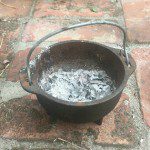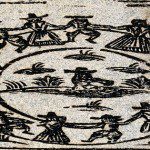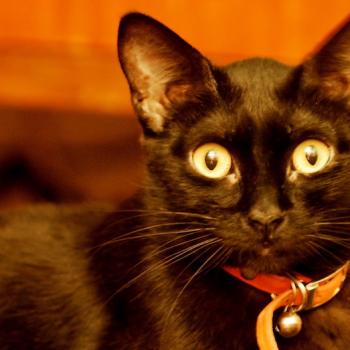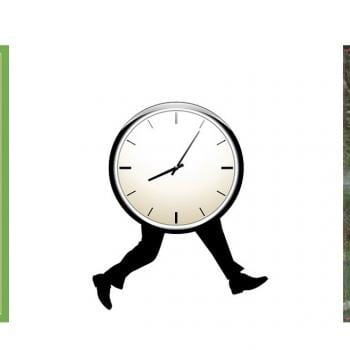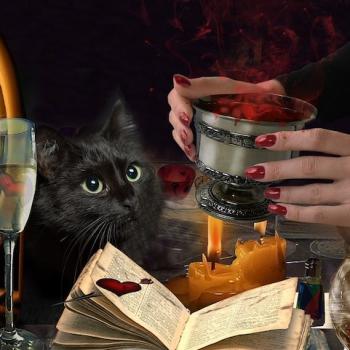We tend to take published rituals for granted today. Between websites, e-books, and bookstores there are probably hundreds of different “Books of Shadows” available for perusal and personal use. But that’s a modern development, and it took nearly twenty years from the Craft first going public for easily available ritual books and BoS’s to become available. In many ways these early books brought the BoS out of the shadows and into the light, though they were not without controversy.
The earliest Witchcraft books didn’t include much in the way of rituals. They tended to include a lot of history along with a general overview of what Witches believed back in the 1950’s and 1960’s. Periodically such books might contain a small ritual bit, but there was nothing in them to guide a practitioner in a ritual from start to finish. To receive Witch rituals one had to either be an initiate of a tradition or make up their own version of things.
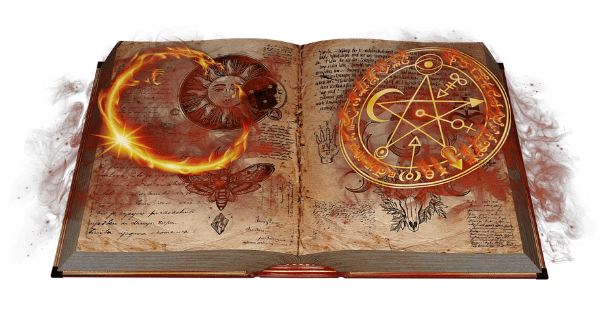
The first attempt at a mass produced BoS appeared in pamphlet form in 1964 and was done in an attempt to devalue the Craft. The BoS included in the pamphlet was allegedly that of Gerald Gardner himself, and published by Charles and Mary Cardell, a couple who liked to pretend they were brother and sister. (If that makes no sense to you, well you aren’t alone, the Cardells were some strange fish.) The Cardells got their copy of Gardner’s alleged BoS from a disgruntled initiate of Gerald’s named Olive Greene (who may have also been their “spy,” I told you the saga of the Cardells was a weird one).
Privately published and not very popular with the Witchcraft community the Cardells’ early attempt at publishing a BoS didn’t work out very well for them and their pamphlet/book was quickly forgotten. Other published BoS’s fared much better in the court of public opinion and have been in print now for several decades. What follows are some of the most popular mass-produced BoS’s, and I think it’s fair to say that they all changed Witchcraft forever, though depending on who you talk to, not always for the better.
From Huson to Sheba to Starhawk: The 1970’s
The first book to contain full length rituals resembling those in Modern Witchcraft was Paul Huson’s Mastering Witchcraft: A Practical Guide for Witches, Warlocks & Covens. Huson’s book was a long way from a BoS, and many of his spells and formulations feel closer to Ceremonial Magic than Witchcraft, but there’s also a lot of the familiar in Huson’s work.
Huson’s book opens with an illustration of the Wheel of the Year before going into a whole lot of spellwork. There are also invocations to deities such as Cernunnos and Diana, pentacles, and familiar exclamations such as “So mote it be!” Much of the material in the first two/thirds of the book is interesting but bears little resemblance to Wiccan-Witchcraft, but that changes in the book’s last chapter The Coven and How to Form One.
Taken (and adapted) from the book: The Witch’s Book of Shadows: The Craft, Lore & Magick of the Witch’s Grimoire by Jason Mankey, Llewellyn Publications, 2017. You can pick yourself up a copy here, or at this link if you live in the UK. (And it’s also at almost every good Witch-shop! Support local business!)
It’s here in the books waning pages that Huson begins outlining more than just spells, he basically provides a primer for creating ones own BoS. He includes two initiation rituals, complete with excerpts such as “Blessed Be thy knees that shall kneel at the Holy Altar,” (1) which is a line common to a whole lot of BoS’s and tradition. Huson’s book also includes the first published version of The Charge of the Goddess, though his version is a bit different from the one most of us are used to.
Huson’s book was a considerable step forward in published Witch rituals, but the biggest (and most contentious) step would come in 1971 with the publication of Lady Sheba’s Book of Shadows. Lady Sheba (born Jessie Wicker Bell in 1920) claimed to have been initiated into Witchcraft back in the 1930’s and that her Book of Shadows came at least partially form that initiation. In actuality Bell had received her BoS, along with a Gardnerian Witchcraft initiation via proxy, in 1970 from English Witches Michael Howard and Rosina Bishop. Bell would later claim that the Goddess had urged her to publish what were most certainly oath-bound rituals. (2)
Sheba’s book was published Llewellyn Publications whose then president, Carl Weschcke, was a part of Bell’s coven. (3) Lady Sheba’s Book of Shadows isn’t quite a complete Witch-BoS but it comes very close. There are sabbat rituals, initiations and elevations, along with The Laws of Witchcraft, known by some as the “Ardanes.” A longer edition would be published the following year as The Grimoire of Lady Sheba and would include even more rituals, along with several magical rites and spells along with and other odds and ends.
To say that Gardnerians were outraged in 1971 when Sheba’s book was published would be an understatement. To this day its publication remains contentious, and by the late 1970’s Bell had retired from public Paganism and Witchcraft. Though Bell’s book was the first to truly present a Witch ritual in order from start to finish, it wasn’t a complete Gardnerian BoS. Bell’s version of a BoS contained a lot of information about rituals, but completely lacked any context for those rituals. A Gardnerian BoS is more than just a collection of rituals, it’s a source of information about the Craft, containing the wisdom of generations of High Priestesses and High Priests. Bell’s book also only represented one particular strand of Gardnerian Craft, and the authors of that particular book (most notably Michael Howard) have admitted to changing certain portions of Gardner’s original. (4)
Despite the misgivings of many Witches Bell’s book has been in print now for over 40 years. In 2001, just a year before Bell’s death, Llewellyn released a beautiful hardcover edition of Sheba’s Grimoire, along with a new edition of her Book of Shadows the following year. Lady Sheba may be gone from this world, but “her” BoS lives on and will continue to influence new generations of Witches.
The next complete Book of Shadows to be published would prove a lot less controversial. 1974’s The Tree: The Complete Book of Saxon Witchcraft by Raymond Buckland would feature no oath-breaking and was the first attempt at a Witch book for the solitary practitioner. Buckland is one of the most influential Witches in history, and that influence goes well beyond The Tree. Buckland was born in London England but emigrated to the United States in the early 1960’s. In the States he would begin corresponding with Gerald Gardner and then later receive an initiation (along with his then wife Rosemary) from Monique Wilson, one of Gardner’s High Priestesses.
The Tree bears a lot of similarities to British Traditional Witchcraft, but Buckland’s sabbat rituals were completely different from those of Gardner and Sheba. With The Tree Buckland essentially created a brand new Wiccan tradition, one he dubbed Seax-Wicca, and one that’s still being practiced today. Buckland’s BoS would also include something sadly lacking in Sheba’s book, context. More than just bare-bones ritual, Buckland’s BoS provided information explaining how his rituals worked. For many years The Tree was the best source for Witchcraft in the tradition of Gardner and his initiates (other than initiation its self of course).
1978 saw the publication of A Book of Pagan Rituals by Samuel Weiser with New York occultist and Witch Herman Slater listed as editor. The material in Pagan Rituals was originally created by a group known as The Pagan Way (which continues to this day) and was passed along in the magazines and Pagan periodicals of the era. The rituals created by the Pagan Way served two functions. The rituals could be used in Outer Court type settings (an Outer Court is a pre-initiation training circle used in some traditions) or in public settings where Witch-style rituals were being shared. Since nothing in the Pagan Way material of that era was oathbound, things could be shared without violating any trusts.
Since much of the material in A Book of Pagan Rituals was designed for groups, many of the rituals and ideas in it lack context, but it also represented a huge step forward in the distribution of Witch-ritual throughout the English speaking world. It was also one of the first books to include the word “Pagan” in its title instead of “Witch” or “Witchcraft,” another milestone.
Hailed as the “Mother of Modern Witchcraft” Doreen Valiente (1922-1999) was one of the great writers and architects of the Modern Craft revival. Initiated by Gerald Gardner in 1953, Valiente would go on to write much of the material found in the Gardnerian Book of Shadows and many of the later books that were influenced by it (or copied it directly). She was a tremendous poet and her words have been a part of my own personal journey as a Witch nearly from the very beginning.
In 1978 she released Witchcraft For Tomorrow, a book so good that writer and Witchcraft historian Philip Heselton has called it her “magnum opus.” (5) Witchcraft For Tomorrow was the first Witchcraft book published in England that provided full rituals for each of the sabbats along with a self-initiation ritual. For many in the United Kingdom Valiente’s 1978 work provided a way into Witchcraft away from the up until then traditional coven structure.
One of the most important books in the history of Modern Witchcraft was released in 1979 and closed off the decade in style. The Spiral Dance: The Rebirth of the Ancient Religion of the Great Goddess was the first great “American Witch Book” with Doreen Valiente calling it “practically a new Book of Shadows.” (6) Starhawk’s book wasn’t just about Witchcraft as practiced by Gardner (and the various off-shoots that used his system) it detailed a new kind of American West Coast Witchcraft, complete with feminism, environmentalism, and the influence of Cora and Victor Anderson, two of the most important Craft teachers in American history (and also the founders of a truly unique Witch tradition).
Starhawk’s book was not meant to be a BoS but it might as well have been. Even today, years after first reading it, I’m amazed at just how many pages in it look like ones from my own BoS, and read like it too. Every spell and rite in The Spiral Dance feels circle tested and as if it was lifted straight from the rituals that must have been going on in Starhawk’s home before it’s publication.
The 1980’s and Beyond: From the Farrars to Cunningham to Ravenwolf
In 1981 English Witches Janet and Stewart Farrar released Eight Sabbats For Witches, featuring rites and ceremonies from the Alexandrian Witchcraft tradition. A companion volume was released in 1984 entitled The Witches’ Way: Principles, Ritual and Beliefs of Modern Witchcraft. Both works featured input from Doreen Valiente, and the three collaborators thought of The Witches’ Way and Eight Sabbats as a way of “publishing a definitive text of the (Gardnerian) Book of Shadows.” (7)
Much like Lady Sheba nearly ten years before, there were some who saw the publication of the Farrars’ books as a violation of their secrecy oaths. But as as Valiente wrote to the Farrars during the lead up to The Witches’ Way: “I am the co-author with Gerald Gardner of the Gardnerian ‘Book of Shadows’ and therefore, it seems to me, I’m entitled to say whether or not it should be published.” (8)
Later collected into one volume as A Witches’ Bible, the Farrars and Valiente succeeded masterfully in their attempt to create a working BoS based on Gardner’s work in the 1950’s. The rituals flow like water, and thanks to Valiente’s participation, the reader knows that everything in both books (or the one collected volume) is being presented in exactly the way the composer of those rites intended. Unlike Lady Sheba’s books in the 1970’s both volumes by the Farrars provide plenty of context while succeeding as a BoS.
Before the internet became our primary form of communication in the extended Pagan world, many Witches and other like minded-folk kept up with one another through magazines and other periodicals. One of the pioneers in this area was Ed Fitch, and his work would have a lasting effect on Witchcraft. Fitch not only helped craft the rituals of the Pagan Way (discussed above) but he also put together two “underground classics” that helped bring Witchcraft-style rituals to the masses.
The Grimoire of the Shadows and The Outer Court Book of Shadows circulated privately throughout the 1970’s (and into the present day) and allowed coven leaders to present rituals without worrying about oath-breaking. (9) (Those two works saw an eventual “official” release in 1996 through Llewellyn Publications as The Outer Court Book of Shadows.) In addition to Fitch’s underground books, he also founded the Witchcraft magazine The Crystal Well in 1965 where he and writer Janine Renee shared several sabbat rites. Those rituals also circulated widely in the Pagan underground and were finally collected and released as Magical Rites From the Crystal Well in 1984.
One of the most influential BoS’s of the past forty years first appeared publicly back in 1989 as “Section III” in Scott Cunningham’s (1956-1993) Wicca: A Guide For the Solitary Practitioner. Cunningham’s Wicca was revolutionary for a number of reasons. Perhaps most importantly it was the first widely circulated book in the United States to use the word “Wicca” in its title instead of Witchcraft. That was a pivotal moment in the history of the Craft and is often overlooked.
The second revolutionary bit in Cunningham’s book was that “Section III” entitled the The Standing Stones Book of Shadows. Standing Stones was a complete BoS with sabbat rituals, spells, and magical oil recipes. For much of the 1990’s (and even up until now) Cunningham served as an entryway into the Craft, and as a result the rituals in his BoS have influenced an entire generation of Witches. I’m not exaggerating when I say that I’ve seen bits of Cunningham’s rites show up in rituals across the United States and Canada. An extended version of Cunningham’s BoS was released in 2009 as Cunningham’s Book of Shadows: The Path of an American Traditionalist.
Another of the most influential American Witches of the 1990’s was Silver Ravenwolf. Her 1994 book, To Ride a Silver Broomstick appealed to the new generation of Witches raised on the movie The Craft and TV’s Charmed. (Confession, Broomstick was one of my absolute favorite books as a young Witch, and still is.) Ravenwolf’s 2003 Solitary Witch: The Ultimate Book of Shadows for the New Generation, clocking in at over 600 pages, might be one of the most complete publisher-produced BoS’s in existence.
In the span of just thirty-five years published BoS’s went from being rather slim affairs (and in the case of Lady Sheba mostly plagiarized) to full and complete volumes to get a coven or solitary practice up and off the ground quickly. It’s amazing to think how far these types of books have come in such a short period of time, and the innovation is not over yet. In addition to BTW (British Traditional Witchcraft) and eclectic-Wicca BoS’s, all sort of other Witchcraft traditions are being shared.
If the last fifty years are any indication publishers will continue to release full BoS’s with many of us in the Craft continuing to buy them. I don’t always use the BoS’s shared by Craft leaders and elders, but I do look to many of them for inspiration when writing a ritual or puzzling over one of Witchcraft’s many mysteries. I hope there are more to come.
Taken (and adapted) from the book: The Witch’s Book of Shadows: The Craft, Lore & Magick of the Witch’s Grimoire by Jason Mankey, Llewellyn Publications, 2017. You can pick yourself up a copy here, or at this link if you live in the UK. (And it’s also at almost every good Witch-shop! Support local business!)
NOTES
1. Huson, Paul, Mastering Witchcraft, G.P. Putnam’s Sons, 1970. My edition, Perigree Books 1980, page 224.
2. Howard, Michael, Modern Wicca: A History From Gerald Gardner to the Present, Llewellyn Publications, 2009. Pages 222-223.
3. Clifton, Chas S., Her Hidden Children: The Rise of Wicca and Paganism in America, AltaMira Press, 2006, pages 96-97.
4. Howard, Modern Wicca, page 223.
5. Heselton, Philip, Doreen Valiente: Witch, The Doreen Valiente Foundation (publishers), 2016, page 191.
6. Valiente, Doreen, The Rebirth of Witchcraft, Phoenix Publishing, 1989, page 187
7. Heselton, Phillip, Doreen Valiente: Witch, page 235.
8. Heselton, Phillip, Doreen Valiente: Witch, page 237.
9. Clifton, Chas, Hidden Children, page 23





